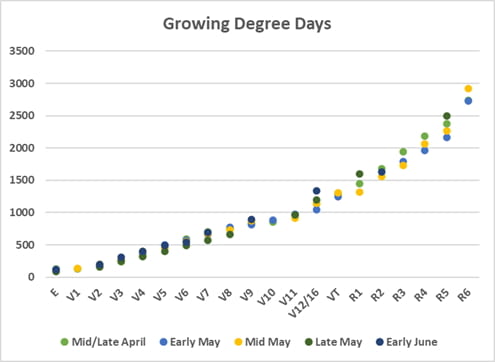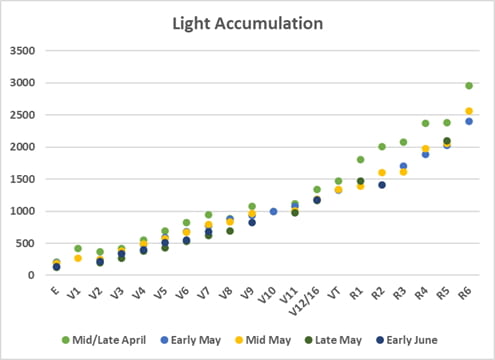Jarrod O. Miller, Extension Agronomist, jarrod@udel.edu; Cory Whaley, Sussex Co. Extension Ag Agent, whaley@udel.edu; Jake Jones, Extension Agriculture Agent, Kent County, jgjones@udel.edu
The standard method used to follow and predict corn growth stages is using growing degree days (GDD). This is a calculation that uses average daily temperatures (https://www.agry.purdue.edu/ext/corn/news/articles.01/Corn_GDD_Calc-0423.pdf) to measure accumulated heat over the growing season. Most of the GDD values we use are from the Midwest, so we have followed a few research fields the past two years to compare how DE lines up. We have also included days from planting and light accumulation (pulled from DEOS) to compare other measurement methods.
As you would expect, our fields follow similar GDD for vegetative growth stages, with emergence, V6 and tasseling growth stages falling within expected ranges (Table 1). The same can be said for reproductive stages, with R1 (1400), R5(2190), and R6 (2700) minimum GDD all close to those observed in DE (Table 2). There is a range in values in each table, due to differences in hybrids as well as just human error.
Table 1: Following Corn Vegetative Growth Stages (2019-2020)
| Emerge | V3 | V6 | V9 | V12 | VT | |
| Days from Planting | 5-13 | 12-31 | 22-48 | 35-63 | 44-76 | 53-82 |
| Growing Degree Days | 84-150 | 219-310 | 492-603 | 787-950 | 1001-1337 | 1231-1322 |
| Total Light | 125-302 | 271-609 | 530-996 | 828-1343 | 1055-1664 | 1265-1508 |
Table 2: Following Corn Reproductive Growth Stages (2019-2020)
| R1 | R2 | R3 | R4 | R5 | R6 | |
| Days from Planting | 59-82 | 60-90 | 67-96 | 83-106 | 78-118 | 106-138 |
| Growing Degree Days | 1320-1594 | 1559-1684 | 1733-2003 | 1957-2187 | 2028-2509 | 2686-2926 |
| Total Light | 1389-1804 | 1408-2003 | 1616-2147 | 1887-2367 | 1845-2567 | 2351-2952 |
“Days since planting” is an easy measurement, however early planted corn will suffer from slow growth due to cooler temperatures. This can be seen in Figure 1, where mid-April planted corn always takes more days to reach each growth stage. From Table 2, the 138 days to reach blacklayer is related more to the lack of heat units in early 2020 rather than the maturity rating of the crop.
Growing degree days (Figure 2) has a much tighter grouping in the vegetative stage, since it relies on actual temperature measurements. The spread in points seen in reproductive stages is due to the subjective rating of kernel development, since each ear may have kernels at two reproductive stages as it transitions. The vegetative stages use a leaf counting method, which limits human variability in staging the crop.
Using light accumulation provides a similar graph to “days since planting” (Figure 3). Early germination will rely on soil temperature, and not light, so that early April planting appears to need more light to mature. Light is an energy measurement, which will correlate to heat, but probably related better to later vegetative and reproductive stages, compared to early season.
The take home point is that GDD remains a good milestone system for measuring or predicting corn stages for timing nutrient, fungicide, and irrigation applications.
Figure 1. Days since planted versus corn growth stage for five planting windows.
Figure 2. Growing degree days versus corn growth stage for five planting windows.
Figure 3. Light accumulation versus corn growth stage for five planting windows.



